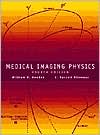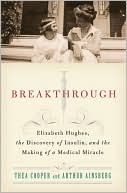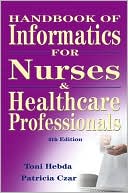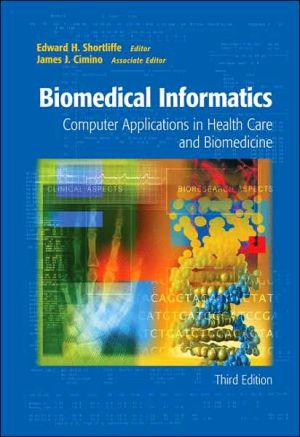Medical Imaging Physics
This comprehensive publication covers all aspects of image formation in modern medical imaging modalities, from radiography, fluoroscopy, and computed tomography, to magnetic resonance imaging and ultrasound. It addresses the techniques and instrumentation used in the rapidly changing field of medical imaging. Now in its fourth edition, this text provides the reader with the tools necessary to be comfortable with the physical principles, equipment, and procedures used in...
Search in google:
This comprehensive publication covers all aspects of image formation in modern medical imaging modalities, from radiography, fluoroscopy, and computed tomography, to magnetic resonance imaging and ultrasound. It addresses the techniques and instrumentation used in the rapidly changing field of medical imaging. Now in its fourth edition, this text provides the reader with the tools necessary to be comfortable with the physical principles, equipment, and procedures used in diagnostic imaging, as well as appreciate the capabilities and limitations of the technologies. Doody Review Services Reviewer:David E Miller, PhD(University of Colorado Health Sciences Center)Description:This new edition provides a detailed overview of medical imaging and radiation physics. It is meant as a didactic tool and focuses on the underlying physics and technology employed in state-of-the-art diagnostic radiology. The third edition was published in 1992.Purpose:The authors? intent is to provide students with a solid foundation in the physics of medical imaging. There are few books with this goal that are also technologically current, making the fourth edition of this text particularly welcome. The first edition was originally compiled from lectures in medical radiation physics. Accordingly, this textbook provides ample theoretical explanations, illustrations, examples, and homework problems for students. Answers to selected problems appear at the end of the book. Each chapter concludes with a summary highlighting key points to remember. The presentation of the material is clear, easy to follow, and well suited to a didactic study of medical physics. Audience:As stated in the preface, the authors appear to be targeting students in the process of becoming physicians, physicists, engineers, and technologists. In order to satisfy the needs of such a diverse group, the text avoids a rigorous mathematical approach to much of the material. However, there is sufficient technical detail that a background in calculus is useful. The authors provide a short section in the appendix for a review of mathematical principles and Fourier transforms. Upper level undergraduates, graduate students, and residents interested in the physics of medical imaging should find the text appropriate. Both authors are medical physicists and credible authorities on the subjects discussed. Features:The authors begin with a solid description of basic atomic and radiation physics, which is essential in understanding the basis of many imaging devices. From there they discuss the mechanisms of x-ray imaging, nuclear medicine, CT, fluoro, MR, and PET. The text also takes time to discuss probability and statistics, quality control and routine testing, radiation detection and measurement, radiation biology, and safety aspects. Occasionally there are sections on more advanced imaging methods such as functional imaging in MR. However the descriptions tend to be fairly brief. The section on PACS and information systems is oddly placed in the Future Developments chapter and contains rather cursory information. Also, the attempt to steer clear of mathematical complexity has made some sections appear brushed over, as in the case of reconstruction algorithms. The figures and illustrations are helpful in clarifying difficult concepts. The many asides found in the margin sections contain useful information and anecdotes but may make a straight reading of the text more difficult. Assessment:This book meets its goal of providing a foundation of knowledge in medical imaging physics. It provides clear descriptions of difficult concepts while keeping mathematics to a minimum. The examples and problems for students are thought provoking and help solidify an understanding of the material. Readers may want to build upon this foundation by examining books that are specific to an imaging modality or more mathematically rigorous. Though it does not provide sample problems, readers may wish to review Bushberg's The Essential Physics of Medical Imaging, 2nd Edition (Lippincott Williams & Wilkins, 2002), which is a more detailed work targeted at residents and students in medical physics. It contains larger, more descriptive figures and tables, and is a valuable handbook.
PrefacePreface to the First EditionAcknowledgments1Imaging in Medicine12Structure of Matter113Radioactive Decay274Interactions of Radiation455Production of X-Rays696Radiation Quantity and Quality917Interaction of X and [gamma] Rays in the Body1178Radiation Detectors for Quantitative Measurement1279Accumulation and Analysis of Nuclear Data14310Computers and Image Networking16111Probability and Statistics17912Instrumentation for Nuclear Imaging19713Radiography21714Fluoroscopy23515Computed Tomography25116Influences on Image Quality26517Analytic Description of Image Quality28118Visual Perception28919Ultrasound Waves30320Ultrasound Transducers31721Ultrasound Instrumentation33122Doppler Effect34323Fundamentals of Magnetic Resonance35524Magnetic Resonance Imaging and Spectroscopy36725Magnetic Resonance Imaging: Instrumentation, Bioeffects, and Site Planning38926Experimental Radiobiology40327Human Radiobiology41328Protection from External Sources of Radiation43529Protection from Internal Sources of Radiation45530Future Developments in Medical Imaging467App. IReview of Mathematics477App. IIFourier Transform483App. III: Multiples and Prefixes485App. IVMasses in Atomic Mass Units for Neutral Atoms of Stable Nuclides and a Few Unstable Nuclides487Answers to Selected Problems491Index495
\ From the Publisher“...fulfills the authors goal of providing an up-to-date survey of the physics of medical imaging in a format that will appeal to students and educators alike. The coverage of topics is sufficiently comprehensive, making it a suitable introductory text for a number of imaging-oriented courses.” (Radiology, January 2004)\ "The authors…are...experts...but also seasoned teachers…this is evidenced by the clarity of thought and completeness with which they treat each topic in this comprehensive, easily readable textbook." (IEEE Engineering in Medicine and Biology, May/ June 2003)\ "...provides clear descriptions of difficult concepts while keeping mathematics to a minimum. The examples and problems for students are thought provoking and help solidify an understanding of the material." (Doody's)\ "...an excellent introduction to the physics of medical imaging...Medical Imaging Physics is sure to be a favorite of residents, perhaps supplanting Christensen’s Introduction to the Physics of Diagnostic Radiology as the classic radiology residency physics text." (American Journal of Roentgenology, Vol. 180, No. 4, April 2003)\ \ \ \ \ \ From The CriticsReviewer: David E Miller, PhD(University of Colorado Health Sciences Center)\ Description: This new edition provides a detailed overview of medical imaging and radiation physics. It is meant as a didactic tool and focuses on the underlying physics and technology employed in state-of-the-art diagnostic radiology. The third edition was published in 1992.\ Purpose: "The authors' intent is to provide students with a solid foundation in the physics of medical imaging. There are few books with this goal that are also technologically current, making the fourth edition of this text particularly welcome. The first edition was originally compiled from lectures in medical radiation physics. Accordingly, this textbook provides ample theoretical explanations, illustrations, examples, and homework problems for students. Answers to selected problems appear at the end of the book. Each chapter concludes with a summary highlighting key points to remember. The presentation of the material is clear, easy to follow, and well suited to a didactic study of medical physics. "\ Audience: "As stated in the preface, the authors appear to be targeting students in the process of becoming physicians, physicists, engineers, and technologists. In order to satisfy the needs of such a diverse group, the text avoids a rigorous mathematical approach to much of the material. However, there is sufficient technical detail that a background in calculus is useful. The authors provide a short section in the appendix for a review of mathematical principles and Fourier transforms. Upper level undergraduates, graduate students, and residents interested in the physics of medical imaging should find the text appropriate. Both authors are medical physicists and credible authorities on the subjects discussed. "\ Features: "The authors begin with a solid description of basic atomic and radiation physics, which is essential in understanding the basis of many imaging devices. From there they discuss the mechanisms of x-ray imaging, nuclear medicine, CT, fluoro, MR, and PET. The text also takes time to discuss probability and statistics, quality control and routine testing, radiation detection and measurement, radiation biology, and safety aspects. Occasionally there are sections on more advanced imaging methods such as functional imaging in MR. However the descriptions tend to be fairly brief. The section on PACS and information systems is oddly placed in the Future Developments chapter and contains rather cursory information. Also, the attempt to steer clear of mathematical complexity has made some sections appear brushed over, as in the case of reconstruction algorithms. The figures and illustrations are helpful in clarifying difficult concepts. The many asides found in the margin sections contain useful information and anecdotes but may make a straight reading of the text more difficult. "\ Assessment: "This book meets its goal of providing a foundation of knowledge in medical imaging physics. It provides clear descriptions of difficult concepts while keeping mathematics to a minimum. The examples and problems for students are thought provoking and help solidify an understanding of the material. Readers may want to build upon this foundation by examining books that are specific to an imaging modality or more mathematically rigorous. Though it does not provide sample problems, readers may wish to review Bushberg's The Essential Physics of Medical Imaging, 2nd Edition (Lippincott Williams & Wilkins, 2002), which is a more detailed work targeted at residents and students in medical physics. It contains larger, more descriptive figures and tables, and is a valuable handbook. "\ \ \ From The CriticsThe new edition of a text explaining the physical principles of diagnostic imaging practices, technologies, and equipment. Written for medical students with no background in physics, chapters cover the structure of matter, radioactive decay, interact ions of radiation, production of x-rays, radiation quantity and quality, accumulation and analysis of nuclear data, computer and image networking, probability and statistics, instrumentation for nuclear imaging, radiography, fluoroscopy, computed tomography, influences on image quality, ultrasound transducers and instrumentation, magnetic resonance imaging and spectroscopy, radiobiology, protection from external and internal sources of radiation, and future developments. Annotation c. Book News, Inc., Portland, OR (booknews.com)\ \ \ \ \ 3 Stars from Doody\ \








